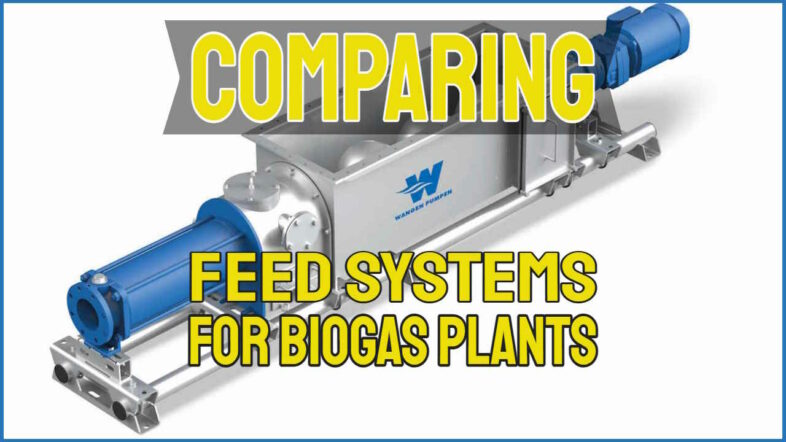Efficient and cost-effective substrate feed systems are essential for biogas plants to maximize their operations, so we thought that we would compare the substrate feed systems for Biogas Plants.
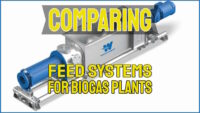 In this article, we conduct a detailed comparison between BIO-MIX technology using WANGEN PUMPEN Progressive Cavity Pumps with the other systems currently offered.
In this article, we conduct a detailed comparison between BIO-MIX technology using WANGEN PUMPEN Progressive Cavity Pumps with the other systems currently offered.
What is the WANGEN PUMPEN BIO-MIX?
The WANGEN BIO-MIX is a feed pump which takes dry feedstocks, eg. silage/maize/chicken
manure, from walking floors or diet feed.
The dry substrate is mixed in the BIO-MIX hopper by an auger with digestate or slurry before
being pumped into the digester.

Introduction
The objective is to provide a comparison of substrate feed systems for Biogas Plants, identify the superiorities of PCP pump-based BIO-MIX technology and provide valuable information for biogas plant operators.
In the anaerobic digestion and biogas industry the most common alternative to progressive cavity pumps is the use of centrifugal pump technology. In fact, most AD plants, designed 10 years ago and more, were equipped with centrifugal pumps rated for sewage pumping applications which were pressed into duty for substrate feed and discharge, with varying success.
The Physical Difference Between Progressive Cavity Pump Technology and Centrifugal Pumps
Both types of pumps comprise an electric motor which turns a shaft, but from that point on these two pump types are very different.
Progressive cavity pumps (PCPs) use a helical rotor and flexible stator, creating sealed cavities that move along the pump, maintaining a consistent flow rate even with varying pressure heads. They can handle viscous fluids and solids, offering higher efficiency across a wide range of pressure heads.
Centrifugal pumps use an impeller which turns rapidly to rotate the fluid. By imparting kinetic energy on the fluid, a centrifugal pressure head is created across the pump with the flow rate dependent on the system's pressure head. The higher the head that a centrifugal pump is subjected to the lower the flow. The “flow/pumping head/energy use” characteristic pump curve, that all pump suppliers and manufacturers will provide for each of the available impeller size combinations across their pump range, illustrates this dependency.
For a centrifugal pump and any particular impeller geometry, the curve shows a point of greatest efficiency, known as the optimum duty point. On either side of the optimum duty point, and at any given flow rate and pressure head, the curve shows that deviations from the optimal operating point will result in reduced efficiency and flow rate.
These pumps are also less suitable for handling viscous fluids or slurries containing solids. The high rotation speed of centrifugal pumps entails rapidly increasing energy use as viscosity rises which reduces the efficiency of centrifugal pumps in this application. However, there is another point to make about centrifugal pumps for biogas plant slurries.
That is that the most efficient centrifugal pumps are those supplied for potable water use because they have only a small gap between the impeller blades and the pump casing. A wider gap reduces the efficiency, but to pass slurry solids the gap between the impeller and the casing has to be widened. This compromises the efficiency of centrifugal pumps when used in this application. No such requirement exists for PCPs which to a large extent explains their higher efficiency.
As a result of the different pump designs of PCPs and centrifugal pumps, the physical differences in the pumping mechanisms of progressive cavity and centrifugal pumps result in different flow rate behaviours against varying hydraulic pressure heads. The result is that PCPs can maintain a constant flow rate, while centrifugal pumps' flow rates fluctuate with changes in pressure head.
Both pump types can be fitted with variable speed drives, but again, the centrifugal pumps can only be slowed to a lesser degree than is possible for a PCP.
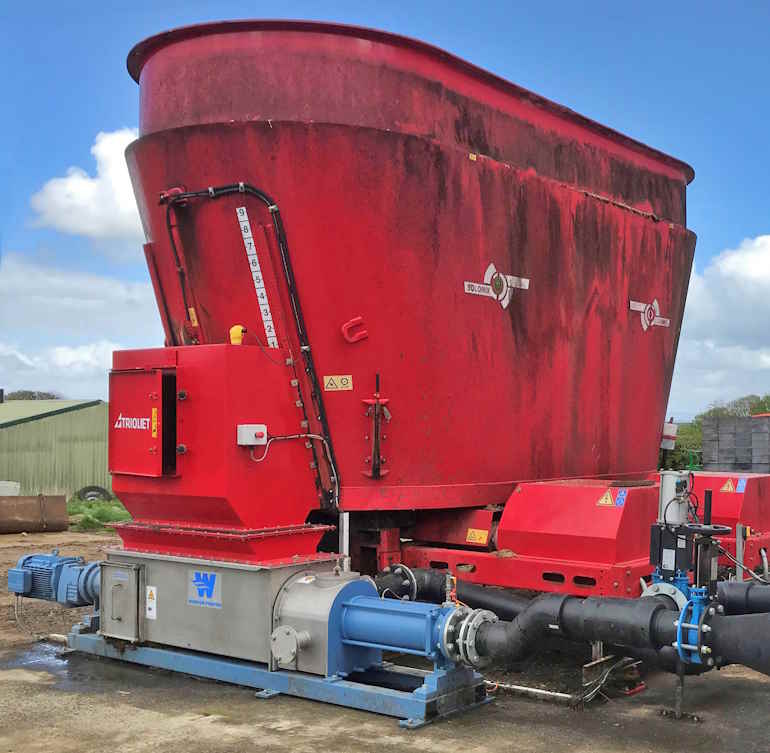
Image: An auger-fed WANGEN PUMPEN Positive Displacement Pump in use at an AD plant, with a hopper feed system above it, provides for simple but highly reliable and efficient digester substrate feed delivery.
Progressive Cavity – Service Life:
WANGEN PUMPEN Progressive Cavity Pumps are renowned for their robust and durable design, ensuring a long service life. These pumps offer a larger passage, minimizing the risk of clogging and requiring minimal maintenance. In contrast, other systems often suffer from higher wear and tear to the cutting blades they need in order not to clog with fibrous materials. The result can be more frequent maintenance and potential breakdowns.
Operating Track Record:
The BIO-MIX technology, powered by WANGEN PUMPEN Progressive Cavity Pumps, has been successfully implemented in over 1000 biogas plants globally. This proven system is designed with only two drive units: BIO-MIX and the feeding pump.
The simplified configuration enhances operational reliability, reducing the likelihood of malfunctions and ensuring reliable operation. Furthermore, operators have the option to incorporate a stone trap within the WANGEN PUMPEN system, providing additional anti-blockage measures and ease of maintenance.
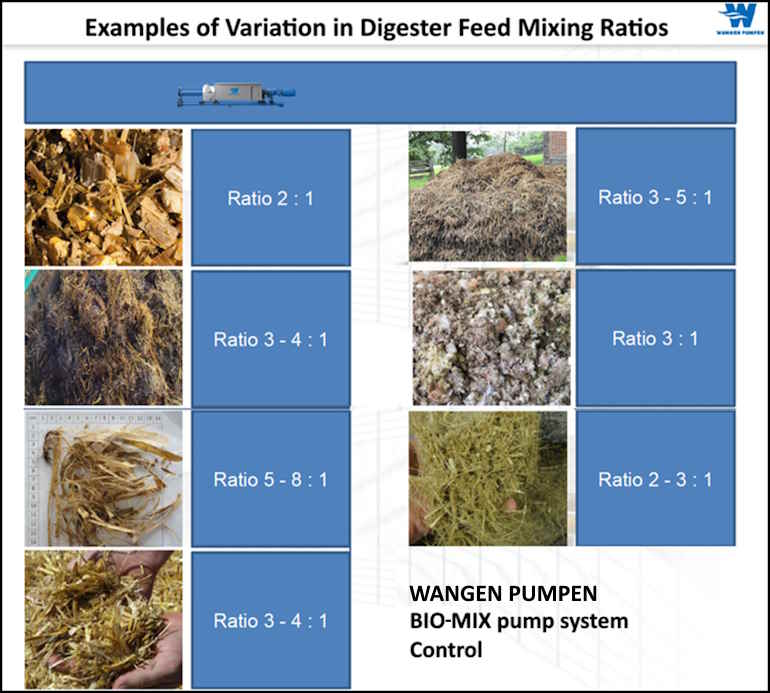
Table 1 – WANGEN PUMPEN systems provide flexible control over widely varying feed material ratios like these.
Operating Costs:
An analysis of energy costs during operation by WANGEN PUMPEN pumps demonstrates the cost-effectiveness of BIO-MIX using WANGEN PUMPEN Progressive Cavity Pumps. With an actual performance capacity of 40m³/h at 16 kW/h, the annual energy cost amounts to €5760. In comparison, other systems using centrifugal pumps typically require an average of 25 kW/h, resulting in energy costs of approximately €9000 per year.
With the current cost of electricity at an all-time high these calculations indicate significant savings with BIO-MIX technology substrate feed systems for biogas plants.
Area of Application:
Flexibility in handling various input substances (see the image below for examples of mixing ratios) without requiring costly system alterations is a crucial advantage of BIO-MIX using WANGEN PUMPEN Progressive Cavity Pumps. The system can efficiently process a wide range of feedstock, including maize, turnips, grass, and dung.
The WANGEN PUMPEN feed mixing system is equipped with an automated control system to ensure varying mixing ratios and water content. can also be easily achieved.
This flexibility allows operators to adapt to different feedstock availability without expending large amounts of operator time to get just the right C:N balance etc.
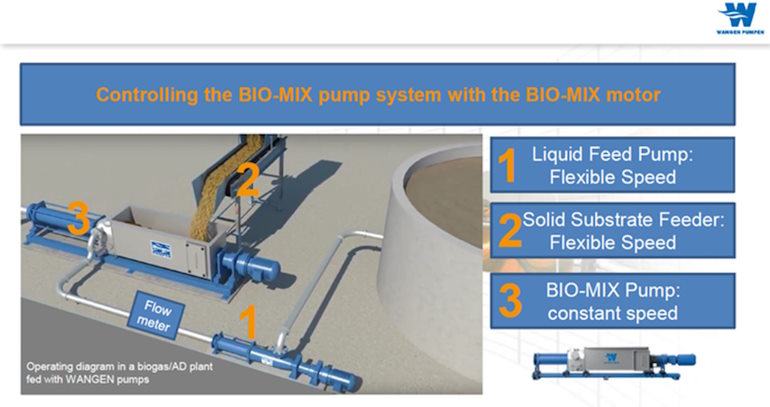
Conclusion to our Comparison of Substrate Feed Systems for Biogas Plants:
WANGEN PUMPEN Progressive Cavity Pumps offer higher volume yield and time efficiency in processing solid materials with large flow rates. In contrast, the centrifugal pumps employed in other systems often face limitations due to smaller opening sizes/smaller maximum particle sizes and increased wear and tear on knife cutters.
The advanced controllability of BIO-MIX technology ensures optimal utilization of input substances, resulting in higher biogas production.
BIO-MIX technology utilizing WANGEN PUMPEN Progressive Cavity Pumps therefore routinely emerges as the superior choice for substrate feed and digestate systems in biogas plants.
Its extended service life, operating reliability, cost-effectiveness, flexibility, and efficiency make it a compelling solution for many biogas plant operators.
We hope you found that this comprehensive comparison of the WANGEN PUMPEN BIO-MIX Progressive Cavity based system versus other centrifugal-pump-based biogas plant feed systems, provides valuable insights for biogas plant operators seeking to optimize their operations.
References:
- WANGEN PUMPEN PDF: “Technology comparison: Substrate feed in biogas plants”. Available at: https://www.WANGEN PUMPEN.com/pdf/en/Flyer_BIO-MIX_Vergleich_EN_web.pdf?m=1569421136&
- WANGEN PUMPEN Website https://www.WANGEN PUMPEN.com/en/products/applications/biogas/
- Other research data and analyses as conducted by biogas industry experts and engineering professionals.

